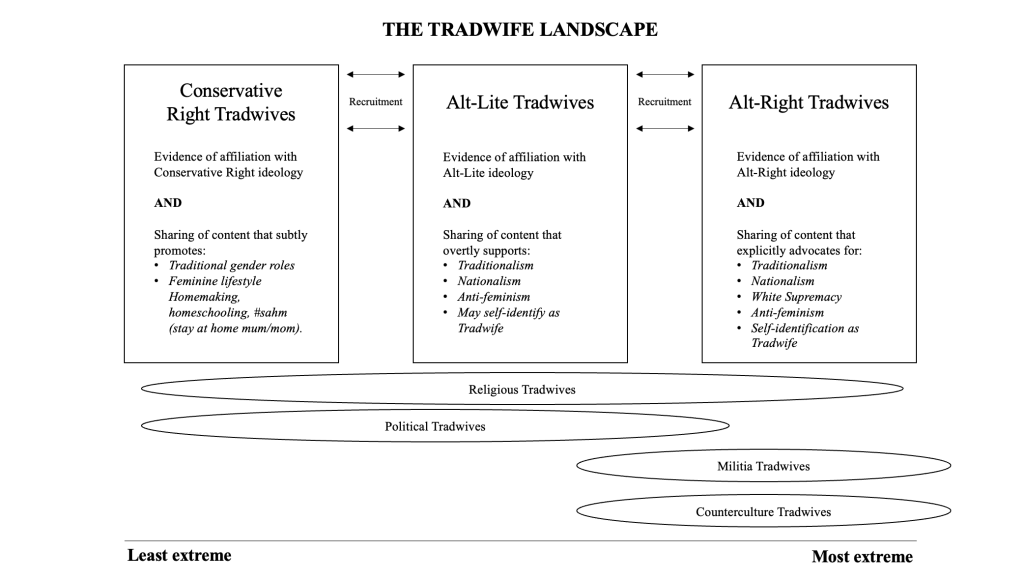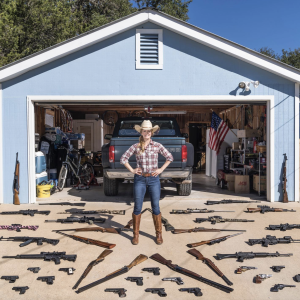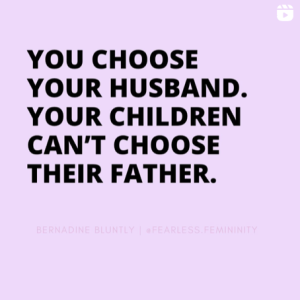Introduction
Gaining prominence since 2020, Tradwives are an influential online community of right-wing women who espouse a highly traditional heteronormative rendition of the ‘wife and mother’ role that is equal parts ideology and aesthetic. Presenting a softer and more palatable voice for right-wing ideology through their construction of a #tradlife, Tradwives use their presence on social media to offer a powerful female in-group association and supply often extremist solutions to perceived demands placed on both women and men in modern Western societies. Over the course of ten months, the authors tracked the online activity of 36 Tradwives and found that these women use ideological radicalisation, social media influencing, and a sophisticated understanding of social media platforms to commodify right-wing ideology.
Tradwife Expressions of Right-Wing Ideology
Tradwives span the right-wing landscape and (re)produce the right-wing communities they inhabit, perpetuating conservative values and right-wing ideologies to varying degrees across social media. Coined the ‘Tradwife Landscape’, these women primarily fitted into one of three contemporarily used right-wing positions; Conservative Right, Alt-Lite, and Alt-Right. Within these positions, Tradwives promoted their place in and the broader tenets of their various right-wing communities including religion, politics, the modern militia movement, and online counterculture.

Fig. 1: The Tradwife Landscape (Sykes, 2023)
Conservative Right Tradwives advocate for a #Tradlife within the home, supporting their husbands and children. These Tradwives had clear conservative values on politics and religion but, on the whole, did not overtly engage with issues of race. Conversely, Alt-Right Tradwives were less characterised by the traditional housewife framing and instead presented an ideological online persona rooted in Alt-Right identities which enshrined value systems such as white supremacy, heteropatriarchy, and anti-feminism. Alt-Lite Tradwives were the bridge between Conservative Right and Alt-Right women, presenting a blended balance between the traditional feminine persona of Conservative Tradwives, and the ideologically driven Alt-Right. These Alt-Lite Tradwives broadly aligned with beliefs of the Alt-Right (i.e., traditionalism, nationalism, anti-feminism), but did not subscribe to white supremacy, instead projecting the continuation of Eurocentric culture, as opposed to the continuation of the white race.
Although levels of ideological affiliation among Tradwives are not necessarily mutually exclusive (i.e., the same woman can have religious as well as politically extreme right-wing affiliation), Tradwives appeared to prioritise one expression to curate their unique online identity. For example, Religious Tradwives (Fig. 2-4) were generally fundamentalist Christian or Pagan women who promoted a socially conservative, traditionalist way of life and family, alongside opposing progressivism, feminism, reproductive rights, LGBTQIA+ rights, and gender equality. The level of right-wing extremist sentiment presented by Religious Tradwives was largely determined by their adoption of theism. Christian Tradwives were often Conservative Right, with their presentation on social media largely dictated by the bounds of biblical femininity. These women were the most modestly dressed, with some wearing head coverings to reflect the extent of their wifely submission. In contrast, the more spiritual features of the Pagan belief system (i.e. conspirituality, and the adoption of archetypes), resulted in Pagan Tradwives holding more autonomy to communicate the depths of their ideological position. These women typically presented as Alt-Right advocates, rather than conservative housewives.



Fig. 2-4: Religious Tradwife aesthetic
Likewise, Political Tradwives (Fig. 5-7) ranged across the right-wing spectrum from Republican advocates to defenders of paleo-conservatism and extreme nationalism, as well as spokeswomen for the Alt-Right. As right-wing political activists, these women communicated an ultimate rejection of feminism, a leftist perspective, and the perceived liberal ‘agenda’. Cast as more modern women, Political Tradwives projected a balanced persona of feminine empowerment and wifely duty.



Fig. 5-7: Political Tradwife aesthetic
Militia Tradwives (Fig. 8-10) represented a publicising of women’s roles in the modern militia movement and promoted appealing constructions of the militia beyond notions of plaid-shirt white men existing on the political fringe. Balancing Alt-Right advocacy with apocalyptical prophesying, Militia Tradwives further prioritised ‘prepper’ ideology through the lens of traditional femininity.



Fig. 8-10: Militia Tradwife aesthetic
Counterculture Tradwives (Fig. 11-13) used their social media presence to advocate for extreme right-wing ideology through an inherent promotion of women as reproducers of the white race. Presenting the tension between feminism and femininity as a culture war, these women heavily critiqued the contemporary social emphasis on identity politics, disparaging social and political correctness, and so-called ‘woke normies’.



Fig. 11-13: Counterculture Tradwife aesthetic
More Than a Pretty Face: Online Strategies of Tradwives
Despite their different locations on the Tradwife landscape, all of these women were skilled social media influencers. Success on social media is ultimately about branding, aesthetics and platform management. Tradwives curated online versions of themselves that allowed them to harness the strength of social media platforms via strategically managing platform regulation and socially sanctioned norms. Functionally, this led to different levels of content extremity, content formatting, and messaging from the same Tradwife across the social media ecosystem (Twitter, Instagram, YouTube, etc). Tradwives learnt to adapt their content to exploit social media algorithms and avoid de-platforming. This strategy highlighted a relationship between platform regulation and the extremity of right-wing content posted.
On highly regulated platforms such as Instagram and Facebook, Tradwives directed their content towards promoting the anti-feminist and, highly feminised nature of their identity. Typically sharing homemaking, cleaning, and beauty content, these social media platforms were used to attract an engaged audience of mostly women (but also men) through presentations of the #tradlife – an online reality oozing happiness, love, security and emotional contentment that is projected as both desirable and attainable.
In contrast, Tradwife content on less regulated platforms such as YouTube, Twitter, and fringe social media (i.e. Gab, Odyssey, Rumble) was far more ideologically driven and attempted to redpill followers by pulling them down conscious rabbit holes that typically promoted extreme right-wing positions on contemporary issues, such as abortion rights, transgenderism, and vaccinations. On these platforms, Tradwife followers were offered in-group association and parasocial relationships with the intention of strengthening right-wing community membership and legitimising extreme religious, political, and ideological positions. Therefore, as platform regulation decreases, the opportunity for radicalisation increases.
Although radicalisation from the left to right did not appear to be a distinct feature of Tradwife online identities (as their content and brand positioning are largely geared towards appealing to a right-wing leaning audience), Tradwives actively contributed to a deepening of right-wing affiliation both in their followers and within themselves. In some cases, Tradwife online identities themselves became more conservative and/or extreme over time. By strategically sympathising with the factors which may pull followers to the Tradwife cause (i.e. right-wing belief systems, political ideologies, membership and belonging within social communities), and convincingly refuting the factors which may push them away (i.e. disconnection with the Tradwife ideology, ideological burn-out and loss of faith in the Tradwife movement), Tradwives actively facilitated this deepening of commitment.
These extreme right-wing positions in turn exposed the more radical elements of Tradwife culture including Christian Nationalism and white supremacy. While all Tradwives expressed religious affiliation as an inherent element of their belief system (secularity does not appear to be a defining feature of Tradwives), the more extreme women attempted to exploit this religious affiliation and use it to recruit and radicalise others. Often defined as the ‘Proverbs 31’ mentality, some women framed the Tradwife persona as a direction from God. In turn, labelling those who adopt more liberal or feminist ideals as acting in the interests of Satan. In directing women towards this Proverbs 31 mentality, Tradwives further encouraged submission to their husband alongside a commitment to work hard for God, the home, and the benefit of others – “The Proverbs 31 woman worked… But she did it out of a heart to bless her home, not to ‘become somebody’ or to find fulfilment in those things”. One Tradwife used her social media presence as a dating site for her followers, presenting the profiles of ‘smitten singles’ which included defining factors such as height, weight, faith, and prioritising the white race and ethnicity. Taken one step further, Alt-Right Tradwives were seen to weaponise religion through either directly or indirectly imposing the supremacy of white culture and the white race as being both closer to God, and the truest form of physical attraction and beauty.
Commodifying Right-Wing Ideology
Tradwives are social media influencers and are as motivated by financial gain as they are by ideological radicalisation. Tradwives have harnessed influencer culture and theories of online marketing to bolster their success by blending the art of social media aesthetics with the science of social media platform management and monetisation. Social influencing is one of the most popular and effective forms of online marketing with its global market value reaching 13.8 billion USD in 2021 (a figure which has more than doubled since 2019). Theorised as the ‘attention economy’, an influencer’s profitability relies on the attention of their followers and is measured via social media platform features such as likes, shares, and follows. Influencers such as Tradwives capitalise on the attention economy and use self-branding rooted in perceived authenticity to develop and maintain a highly engaged audience that in turn can facilitate revenue streams via advertising, brand collaboration, and promotions.
Typically leading communities of between 20,000 and 200,000 followers, Tradwife sites were not only significant in size but probably highly lucrative. These women demonstrated a comprehensive understanding of influencer culture and a sophisticated understanding of what sort of content performs and generates the greatest reach on each platform. Cleverly marketing their personal brand across the social media ecosystem, Tradwives commodified right-wing ideology through social influence. Income was most commonly generated through ad revenue, brand partnerships, or the creation of small online businesses (i.e. clothing, homemaking toolkits, home-schooling resources), all of which were marketed as both highly appealing to followers, and geared toward the adoption of Tradwife culture – thus extending, popularising, and reproducing the Tradwife name and brand.
Rooted in a perceived decline of patriarchy and the undermining of the imperative role of women within the family unit, Tradwives used commodification to encourage societal reinvigoration of conservative religious and fundamental heteronormative values of sex and gender. In buying into the Tradwife value system and increasingly taking up these conservative and fundamentalist positions, followers were, directly and indirectly, consuming the restrictive elements of right-wing ideology, including xenophobia, patriarchal social order, anti-globalism, and racial and ethnic supremacy. By leading and promoting the adoption of a lifestyle centred around the home (i.e. home-schooling, home-birthing, homesteading), Tradwives also ingrained a perpetual lack of trust in government and science through rejecting contemporary schooling and healthcare (for example). By extension, the influence of right-wing ideological entrenchment extended far beyond Tradwives and their online community(ies). The intergenerational impact of narrow, limiting, and highly traditional ideologies is a direct implication of the way Tradwives present, engage, and commodify their culture on social media.
Conclusion
Tradwives have successfully infiltrated mainstream social media with their anti-globalist, anti-modern approach to life. Capitalising on the regulatory bounds (or lack thereof) of social media, they preserve their relevance. In the adoption of an influencer status and commodification of private traditional lives, Tradwives offer a viable career that attributes currency to the promotion of right-wing ideology.
In an age where progressivism is increasingly in the spotlight and the power of feminism is stronger than ever, women who do not fit into the mainstream have created an alternative space. Promoting a counterculture fuelled by anti-feminism and heteronormative traditional living, the Tradwife persona offers women security and freedom to be content within a prioritisation of traditional heteronormative gender. With unprecedented levels of uncertainty facing the world through political, economic, environmental, and social challenges, the security and coherence of conservatism can undoubtedly be considered a protective factor for many women.
Ultimately, Tradwives challenge the modern role of women in society by co-opting and retrenching patriarchy in both traditional and creative new ways. Using their position of influence to perpetuate contentious perspectives on wifely submission, abortion rights, birth control, racism, and the LGBTQIA+ community, Tradwives actively contribute to societal shifts towards more conservative, more traditional living. While it is often argued individual opinion and diversity of thought are important, freedom of speech is not without consequence. At its extreme, Tradwife culture commodifies the politics of division and intolerance that inevitably threatens social cohesion.
Sophia Sykes is a postgraduate researcher at Massey University in Aotearoa New Zealand. She is fascinated by the micro-communities existing within the online extremism landscape – who they are, how they function, and their interconnectedness. Having recently completed her Master’s thesis on Tradwives, Sophia is hoping to embark on a PhD in 2024 to understand the extent to which left-wing extremism is related to violence.
Dr Veronica Hopner is a Senior Lecturer in the School of Psychology at Massey University in Aotearoa New Zealand. She contributes to the intersections of academic, government and community enterprise in preventing and countering violent extremism. Her research interests include the psychology of dis&mis information and conspiracy theories, the role of women in right-wing extremism, and how violence manifests through left-wing extremism. Veronica holds a PhD in Psychology, and a Postgraduate Diploma in Defence and Security Studies from Massey University.
